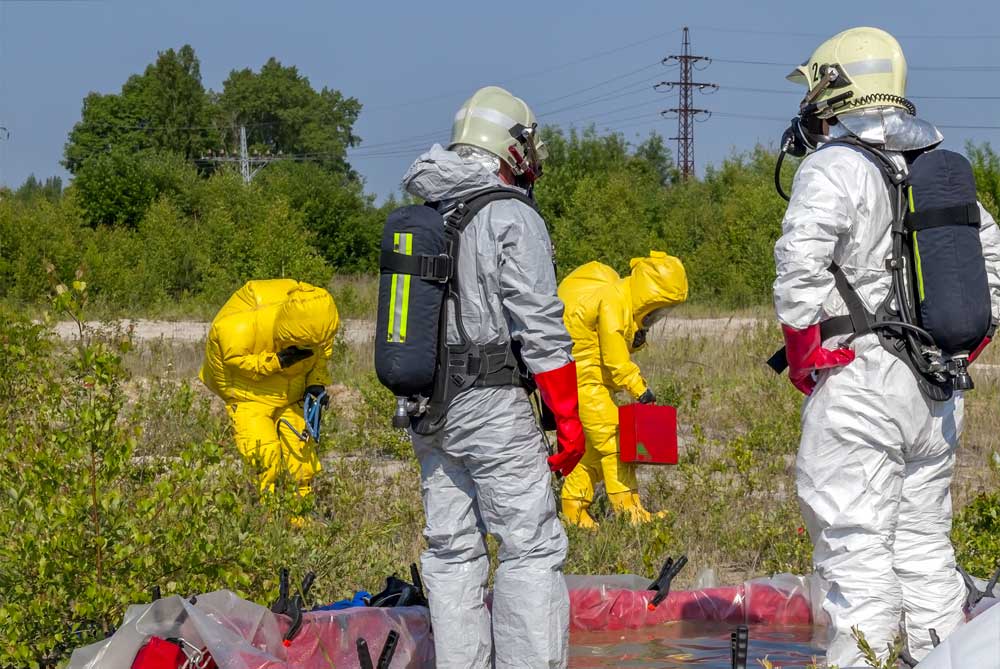Disclaimer: The information on our website is provided for general information purposes only. We make no representations or warranties of any kind, express or implied, about the completeness, accuracy, reliability, suitability or availability with respect to the website or the information contained on our website for any purpose. Any reliance on such information is therefore strictly at your own risk and we are not liable for any damages or losses arising out of or resulting from your reliance on any information contained on our website.
A Hazardous Materials (or HAZMAT) worker is able to identify hazardous materials, safely handle the material, and remove that material. Additionally, they could be called to work at a landfill, construction site, and unexpected spill locations. Watch a video to learn what a HAZMAT worker does:
How to Become a HAZMAT Worker
According to O*NET OnLine, most HAZMAT removal workers do not hold a college degree. However, some report earning a post-secondary certificate. Though a college degree is not necessary, there is extensive on-the-job training plus training from the Occupational Safety and Health Administration (OSHA). From there, you’ll have classroom instruction and be trained in the field. You’ll concentrate a lot of time on safety procedures, to include how to protect yourself properly using safety gear. You would also be responsible to complete individual trainings for materials that you will handle. For example, if you handle asbestos or lead, there is a training for that. If you work at a nuclear facility, you’ll take courses that are mandated by the U.S. Nuclear Regulatory Commission.
Job Description
HAZMAT workers may be called to work at a variety of locations and work hours may vary. For instance, they could be called to clean up toxic material that leaked from a transportation truck on an interstate. If a HAZMAT worker is on an emergency or disaster response team, they may find themselves working nights, weekends, and extended hours in order to quickly protect a community and/or the environment.
They could also be called to a location where hazardous substances such as asbestos, lead, radioactive waste, oil, fuel, or contaminated soil were found so that those substances can be safely removed. In some cases, they may also know how to operate heavy equipment to facilitate the quick removal of toxic materials. Along with removing the materials, they would also be responsible to create a barrier (or containment area) if necessary so the unsafe material does not spread.
Safety is a priority of these workers, so they must wear projective gear for prolonged hours. Often, this gear consists of a full protective suite to protect their body. There are also safety procedures they must follow along with federal laws that regulate how to dispose of the toxic materials.
Hazardous Materials (HAZMAT) Removal Worker Career Video Transcript
At old factories, power plants, and other facilities… hazardous materials (or HAZMAT removal workers) clean up and remove materials that would be harmful to people and the environment. Hazmat workers remove lead or asbestos from structures that are undergoing renovation or demolition. They apply chemicals to surfaces, and cut out the material from surfaces or strip the walls, then package the waste. Additionally, they may use sandblasters, scrapers, and vacuums to remove paint, often working in confined spaces or at great heights. They may build scaffolds or containment areas before cleanup.
Hazmat workers also clean up landfills, incinerators, and industrial furnaces. Some work at nuclear facilities and power plants, where they measure and record radiation levels and package radioactive materials for storage. Hazmat workers are also called in to clean up spills from train or truck accidents. Hazmat work is dangerous, and guided by strict safety procedures. Workers wear protective suits and respirators for hours at a time. Most hazmat workers are employed full time, and overtime and shift work are common.
When a disaster occurs, they may travel to work on location for several days or weeks. While a high school diploma or equivalent is the only formal education required, HAZMAT workers receive in-depth on-the-job training. Workers at nuclear facilities must take courses mandated by the U.S. Nuclear Regulatory Commission.
Article Citations
Bureau of Labor Statistics, U.S. Department of Labor, Occupational Outlook Handbook, Hazardous Materials Removal Workers.
National Center for O*NET Development. 47-4041.00. O*NET OnLine.
The career video is in the public domain from the U. S. Department of Labor, Employment and Training Administration.

